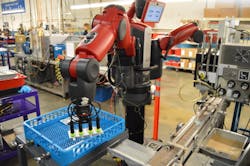Despite producing highly technical components, many established companies are running on lines that depend largely on manual labor. The desire to add automation is often there, but when much of the manufacturing technology is proprietary, it can be very costly. There is also a huge and time-consuming learning curve associated with bringing someone in to understand and link machinery they’ve never seen before.
This was the case for Cornell Dubilier, the largest power capacitor manufacturer in North America. Their Liberty, S.C., facility produces 10,000 different types of products on six lines. The company sought to streamline operations and add flexibility to the highly manual, step-by-step process.
The automation system sought by Cornell Dubilier needed to fit in with their existing framework, without a steep and expensive learning curve. “Quite a few technologies had been reviewed, and we’d been reading about Baxter [the collaborative robot from Rethink Robotics] for some time,” says Daniel Brazinski, manufacturing manager at Cornell Dubilier. “Cost-wise, the technology was a small risk.”
Upon selecting two Baxter robots, Rethink Robotics visited the factory to assess the potential deployments. Cornell Dubilier was careful about its selections, not wanting to make personnel nervous about a new, uncaged robot rolling around the facility.
Beyond Labeling
The first task chosen for Baxter was for a pick-and-place application unloading prismatic capacitors from a labeling machine. This area was chosen because programming for this application proved to be easy and Baxter would be in an area of the plant where workers have plenty of space.
Once Baxter was up and running, an operator noticed that the robot could also check attached brackets while unloading the conveyor. Having Baxter on the line allowed the operator to see ways to improve the process, which got other people thinking. They then looked into whether Baxter could load the labeler as well. It could.
This led to a series of further improvements upstream, such as:
- The labeling speed increased from 125 parts an hour, paced by the operator, to 250 parts an hour, limited by the labeling machine itself.
- The company was able to completely redesign its wash system for efficiency, saving over 200 square feet of production area in the plant.
- All work in process between the wash and labeling steps was eliminated as parts can now flow straight through from one step to the next.
- The need for one employee was eliminated, meaning that this employee could be moved to a more complex task. (Exclusive of retirement or attrition, Cornell Dubilier’s owner made a commitment that no employees would lose their jobs due to automation upgrades.)
All of these innovations came from line level employees as a result of interacting with Baxter. Brazinski says, “What we ended up with is far from what we imagined. People have not only gotten used to Baxter, they’ve embraced it.”
Brazinski notes that Baxter’s human-like facial expressions have been a big factor in the positive reception by employees, even among those at retirement age. When people come in and pat Baxter on the back in the morning, the robot turns around to acknowledge them. The interface makes Baxter part of the team.
Capacitor Inspection
The second deployment at the Cornell Dubilier plant is an operation where Baxter performs unloading and inspection duties. In this application, a PVC sleeve is installed on a capacitor before it runs through a heat-shrink tunnel. It’s important that sleeves are marked with polarity to ensure that customers install the capacitors properly. Baxter unloads the product from the sleeving tunnel and inserts it into a Cornell Dubilier-designed vision system. The parts are inspected by the vision system based on four parameters, including polarity marking, and then dispositioned accordingly. Automating this step, which was previously performed manually, represents additional annual labor savings and an improvement in quality with electronic verification.
Continuous Improvement Tool
Brazinski says that Baxter paid for itself in the first year, but the benefits go far beyond these initial numbers. The Cornell Dubilier manufacturing team is now looking into building a pick-and-place machine in-house using Baxter’s features so they can redeploy the robot to improve other areas of the plant. “Baxter is continuous improvement for us,” says Brazinski.
Looking Ahead
The company currently has a list of six more improvement projects in mind, and is looking at the prospect of Baxter filling production gaps for certain tasks in these projects. For example, if an operator were absent, Baxter could be placed in one of its pre-defined roles to allow an operator to be shifted to the missing spot.
With Baxter now a part of Cornell Dubilier’s manufacturing operations, the engineers can focus on engineering and serving customers, while the manufacturing team can look at further improvements to the process.
“The hardest part is that everyone has so many good ideas for Baxter,” says Brazinski. “It’s a great problem to have.”

